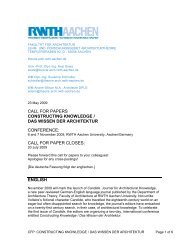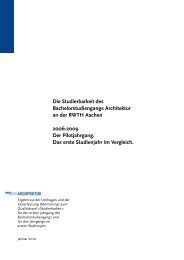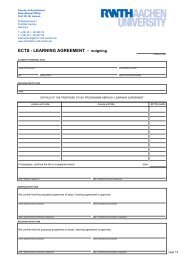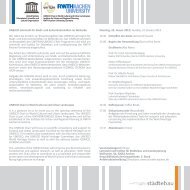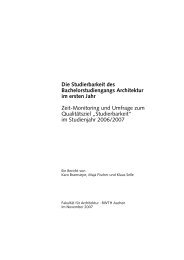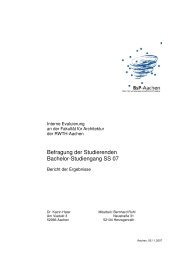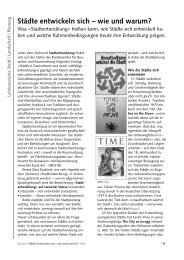Gutachten Dresden_englisch_dritte f.indd - Fakultät für Architektur ...
Gutachten Dresden_englisch_dritte f.indd - Fakultät für Architektur ...
Gutachten Dresden_englisch_dritte f.indd - Fakultät für Architektur ...
Create successful ePaper yourself
Turn your PDF publications into a flip-book with our unique Google optimized e-Paper software.
4.3 Conclusion<br />
Evidently, artists from different periods viewed the city of <strong>Dresden</strong> and the landscape<br />
of the Elbe Valley in different ways, focussing on different aspects in their depictions.<br />
Artistic views of the city from the east have predominantly focused on the Elbe river<br />
bends and floodplains. Comparing the city views of Hendricksz (17th century), Thiele<br />
(18th century) and Schinkel (early 19th century), the perspective gradually shifts<br />
towards the east. The bend in the Elbe valley between Albert Bridge and Loschwitz<br />
Bridge was increasingly viewed, depicted and used in the composition as a cohesive<br />
stretch of landscape in front of the city of <strong>Dresden</strong>.<br />
Over the 19th century, a number of landmarks and vantage points emerged around the<br />
Elbe river bend which, still today, afford impressive views between Albert Bridge and<br />
Loschwitz Bridge. Franz Wilhelm Leuteritz’s 1868 painting, for example, already shows<br />
the city from “Dinglingers Weinberg” and features the Elbe castles in the foreground.<br />
Geissler’s mid-19th-century “Waldschlösschen view” offers not only a panoramic<br />
perspective of the <strong>Dresden</strong> Altstadt but also includes landmark buildings and outstan-<br />
ding features that have remained highly characteristic of the Elbe valley by Johannstadt<br />
to this day. The painting clearly shows the “Antons an der Elbe” building on the left side<br />
of the Elbe, as well as the two villas that frame the opening Elbe meadows level with<br />
the “Preußisches Viertel” [Prussian Quarter]. The compositional interplay between city<br />
outline, architectural landmarks, elevated vantage points and other dominant features<br />
that still define the Elbe valley between Albert Bridge and Loschwitz Bridge today can<br />
clearly be seen in this 19th-century painting.<br />
The 1930s photograph taken from the Waldschlösschen pavilion demonstrates how<br />
the public perception of this stretch of valley – gradually reinforced over generations<br />
– was “completed” over the intervening years. A prime example of this is the creation<br />
of the public “Königsufer” area under city building officer Paul Wolf, featuring the<br />
Waldschlösschen pavilion as the viewing point of choice.<br />
It appears that as the Elbe valley landscape, particularly the northern hillsides, was<br />
developed and “cultivated” as a recreational and tourist area (as well as a sought-after<br />
residential zone), the significance of this landscape in the depicted city views and the<br />
significance of its vantage points to the visual perception of the city grew correspon-<br />
dingly.<br />
In contrast, the depiction of the cultural landscape of the <strong>Dresden</strong> Elbe Valley seems<br />
to play a comparatively minor role in <strong>Dresden</strong>’s current city promotion materials.<br />
Presumably this is because resources have been focused very strongly on reconstructing<br />
the city’s historic old town over the last years. The recently completed reconstruction<br />
of the Frauenkirche in particular has attracted a large amount of attention, and the<br />
53





